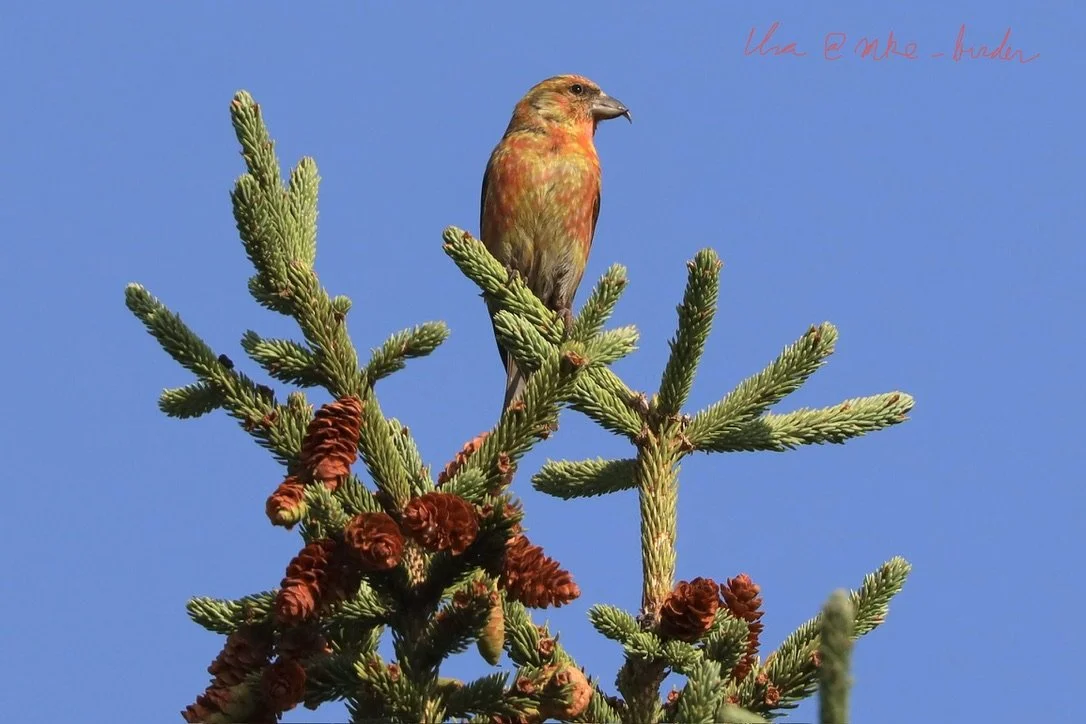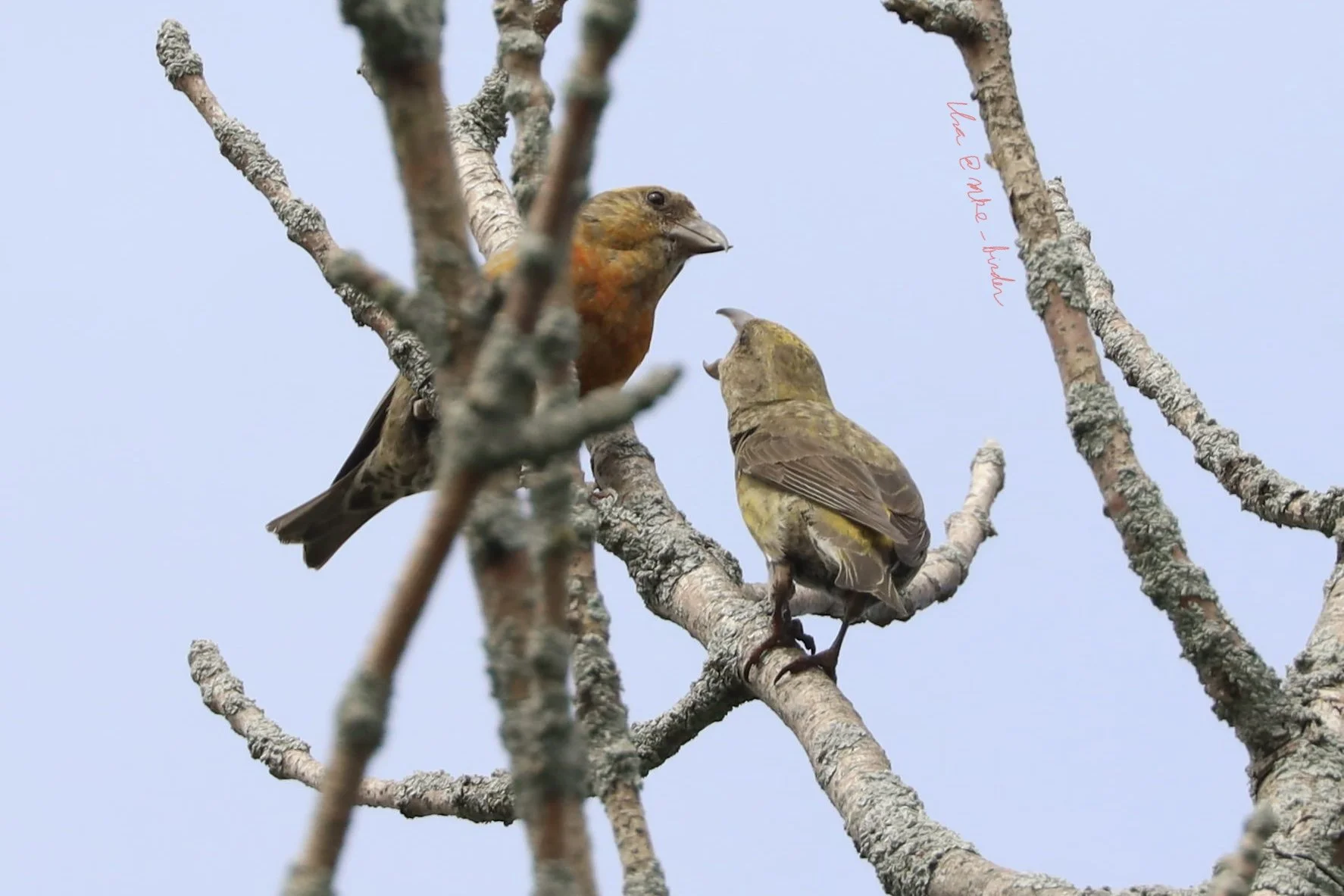
Red Crossbills (Loxia curvirostra)
Forest Beach Migratory Preserve
Ozaukee County, Wisconsin
August 6th, 2013
If you are one of the (very) few devoted followers of my blog, you will certainly remember my unsuccessful attempt to see the flock of Red Crossbills that briefly visited Warnimont Park this summer. Well, I have great news: I finally saw them!
In fact, I saw 10 of them!
****
Getting up early to make the 40-minute drive north to the Forest Beach Migratory Preserve, managed by the Ozaukee-Washington Land Trust (OWLT), we arrived around 8am to begin a trek along the former golf course in search of these animals. I had been lucky to see the White-Winged Crossbills in March, 2022, so it’s only natural that I wanted to see their cousin.
****
Red Crossbills, at least in the USA, are primarily a western and northern species of bird, though there are isolated populations throughout the country in the mountains of southern Appalachia and SE Arizona. There are even a group or “type” in Newfoundland. (More on the different types will be discussed later.) No matter where they reside, they all share a similar characteristic: They specialize in conifer cones. To access the seeds inside, the Crossbill developed, through evolution, its eponymous beak. Crossbills will slide the slender points of their bills between and pry open these hard scales, and with their tongues, grab the seed. Cool, right! (For video on these feeding habits, I would recommend visiting the Cornell Lab or Ornithology website to learn more.)
Yet, there is the occasional irruption of Red Crossbills out of their current ranges. This year may be no different. Yay for me!
****
The first few steps into the restored prairie habitat and bordering woodland produced Eastern Kingbirds, American Goldfinches, and Cedar Waxwings. It was reassuring to see the multiple of bird species after a long, hot summer, notable for days of smoke from the Canadian wildfires. I hadn’t seen as many birds this summer compared to last year, a notion that crossed my mind several times over these few months. Were they ok? Are populations crashing? Did they make an early escape south? Fortunately, those thoughts were pushed aside on what was otherwise a pleasant day.
****
The trees gradually transitioned from deciduous to coniferous trees along the path. Some conifers had young cones, others had mature, hard ones. My neck was experiencing the first tinges of “Warbler Neck” by examining the tops of these tress.
From beyond the fourth conifer, a sound I hadn’t heard before came in. I will be the first to admit I am not the best with vocalizations, but I knew this strangely metallic kip-kip-kip call was different.
Almost on cue, a flock of Red Crossbills alighted on a tree in front of us!
Lifer!
To say I was excited would be an understatement! No more will I have to agonize about missing these wonderfully cute finches in my neck of the woods.
For a mere few seconds, we watched these crossbills take a quick meal from the cones before departing for other trees in the preserve.
I would see them again at the end of the trail, but not until we saw Purple Martins, Clay-Colored Sparrows, and Northern Flickers, to list but a few of the other bird species enjoying the August weather.
****
While their beaks would be interesting enough to learn about, an even more astonishing (infuriating?) fact is the number of types of Red Crossbills. In North America, there are 10 types based on their calls! (There were 11, but Type 9—Cassia Crossbill, was split from the Red Crossbill in 2017.)
So, the question now is which type did I see?
Unfortunately, I don’t know, because these can only be differentiated by call.
Fortunately, I have an audio recording. It will take me some time to find out which type it is then.
I could potentially narrow down the potential choices to type 1, 2, 3, 4, or 7, but that really doesn’t get me anywhere, does it? How does one properly identify the type?
Behold, the internet! Consulting the local online birding community, I was able to communicate with someone who directed me to upload the audio to my checklist. After careful analysis, results came back positive for a Type 4 Douglas-Fir Red Crossbill!
With this new information, I can now study how this species (subspecies?) in more detail, and marvel how this group of birds irrupted from their usual range in the Pacific Northwest to the Midwest in search of suitable cones and habitat
Thank you for reading this post! I hoped you enjoyed it :)
For the above photos, I used a Canon EOS R mirrorless camera with the RF 100mm-500mm F4.5-7.1 IS USM lens.
I referenced the following resources for ornithological information on the Red Crossbill:
https://birdsoftheworld.org/bow/home
https://ebird.org/news/recrtype/
https://finchnetwork.org/species/crossbills/red-crossbill-loxia#site-header
Until next time, keep birding!









